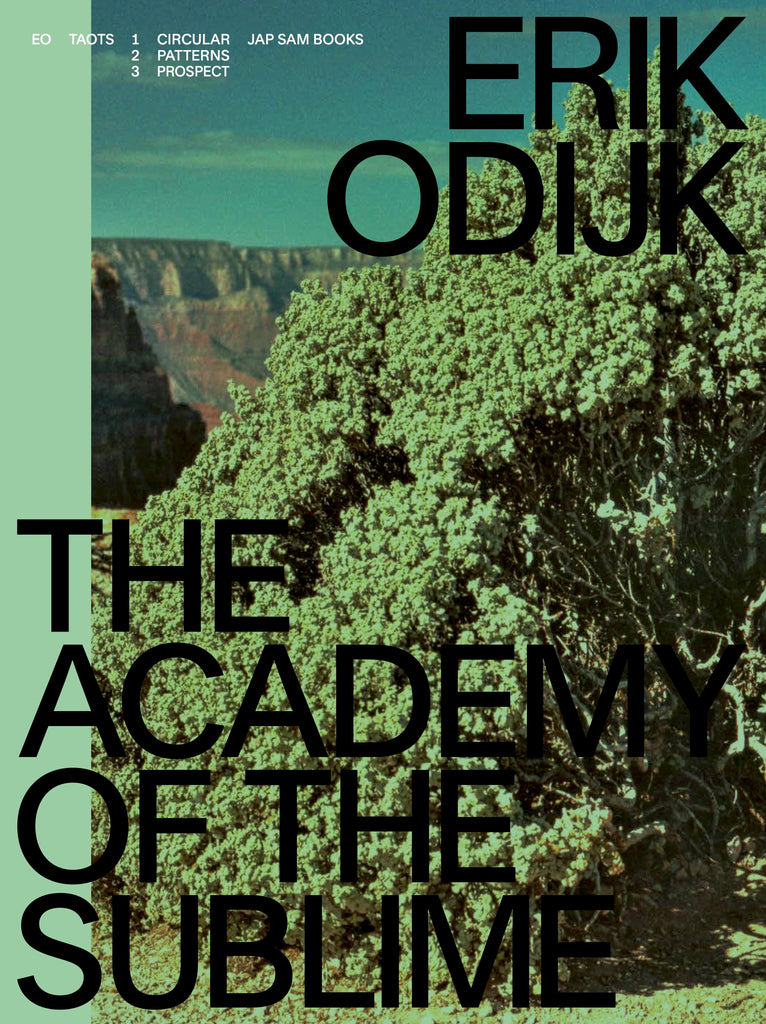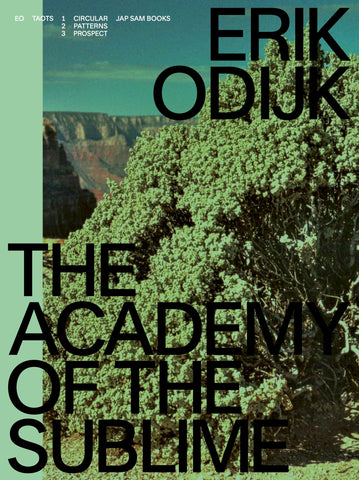Your cart is currently empty!
Art
Erik Odijk. The Academy of the Sublime
+++Erik Odijk. The Academy of the Sublime+++
+++Hans Maarten van den Brink, Anne Bruggenkamp, Erik Odijk, Ilja Leonard Pfeijffer, Paul Roncken+++
978-94-92852-21-2
Studio Joost Grootens (Joost Grootens, Dimitri Jeannottat)
104
27 x 36 cm
Softcover
Printer
Softcover
Numerous illustrations
English / Dutch
Final editor: Eleonoor Jap Sam / Project development, coordination & advice: AB Cultural Producers Anne Hoogewoning, Bonnie Dumanaw
Made possible with the generous support of the Mondriaan Fund, Amsterdams fonds voor de Kunst, Jaap Harten Fonds, and crowdfunding/voordekunst.
+++
‘Erik Odijk makes drawings in his studio and in situ at exhibitions where he draws on the wall. Nature is the protagonist in his oeuvre. The artist roams through untamed landscapes and recapitulates the experience of place in his work. His drawn landscapes have a rugged charm. (…) Erik Odijk depicts the vitality and the darkness of nature. His work is suffused with the idea that the real experience of nature is a euphoric one which is denied to us by our civilized lifestyle. This is why photography is gaining a more prominent role in his present work. Erik Odijk has recently been compiling photographic series relating to his landscape walks. These add an objective angle on the place experience : the photographs are a counterpoint to the drawings, and so expand his study of the experience of nature in the 21st century. (…)’ – Mark Kremer
'With this publication we enjoyed playing around by taking out pages and re-assembling the work of Erik Odijk. With the darker side of nature as his protagonist, the artist intends to show us a euphoric experience that we might have forgotten due to our civilised lifestyle. The designers supported him in his mission by creating a publication that could function as a book or portable exhibition. with its refined red typography on yellow paper and materials that honour and compliment Odijk's work, we loved this publication's mystery and enjoyed our dive in its loose spreads and endless possibilities.' - Student jury The Best Dutch Book Designs 2020
The work of artist Erik Odijk (1959) consists of drawings, photographs and works of art in public space. Odijk is best known for his large drawings, often made on location or in his studio, in which fragments from nature always form the most important visual elements. Drawings that let you wander with your gaze and amaze you about the effects he achieves with mainly black and white drawing material, for example charcoal.
The book The Academy of the Sublimeshows a selection of Erik Odijk's work from 2005 to the present. The book consists of three separate 'magazines' and illustrates the three different disciplines in the artist's oeuvre by means of 150 illustrations. The separate magazines are combined in a single large format folder. The large format allows the viewer/reader to disappear into Odijk's work, as it were, because the details of the work are clearly visible in this way.
With text contributions by artist Erik Odijk, landscape architect Paul Roncken, novelist and poet Ilja Leonard Pfeijffer, artist and writer Anne Bruggenkamp and writer and journalist Hans Maarten van den Brink.
With a beautiful design by Studio Joost Grootens.
'Within the current economic, political and social context in which fear seems so dominate, the dynamics of the Sublime may be particularly relevant. The Sublime can help describe the current depression of the human condition, but also contribute to the formulation of a constructive response. The Sublime is about the experience of an individual who dares to confront and to engage with what is beyond their understanding and knowledge, and tries to make sense of it. It could provide and alternative to the impending madness and the possible disintegration of society.' - Erik Odijk
‘The viewer can become lost in an almost pre‐human world, a world in which people are an anomaly. Often executed in black and white, and often in charcoal, the drawings offer a space that is initially pensive. The experience of and confrontation with nature are crucial for the creation of these pieces.’ – Anne Bruggenkamp
'The oeuvre of Erik Odijk is important because of its trenchant portrayal of one of today’s great issues: our changing perception of nature. His work catches us out with the divided feelings of the nature explorer, who cannot resist the call of the wilderness yet knows that every step taken could add to its destruction.’ – Mark Kremer
'The big advantage of the unbound booklet is that you can have image cuts or meeting another image crudely by folding. But then still, by taking it apart, you access the complete image if you want. Therefore, you could have both, full images and a combination of images.' - Joost Grootens
Erik Odijk. The Academy of the Sublime
€35.00
Erik Odijk. The Academy of the Sublime
Erik Odijk. The Academy of the Sublime
€35.00
Art / Awarded / Landscape | Nature / Photography
978-94-92852-21-2
Studio Joost Grootens (Joost Grootens, Dimitri Jeannottat)
104
27 x 36 cm
Softcover
Printer
Softcover
Numerous illustrations
English / Dutch
Final editor: Eleonoor Jap Sam / Project development, coordination & advice: AB Cultural Producers Anne Hoogewoning, Bonnie Dumanaw
Made possible with the generous support of the Mondriaan Fund, Amsterdams fonds voor de Kunst, Jaap Harten Fonds, and crowdfunding/voordekunst.
‘Erik Odijk makes drawings in his studio and in situ at exhibitions where he draws on the wall. Nature is the protagonist in his oeuvre. The artist roams through untamed landscapes and recapitulates the experience of place in his work. His drawn landscapes have a rugged charm. (…) Erik Odijk depicts the vitality and the darkness of nature. His work is suffused with the idea that the real experience of nature is a euphoric one which is denied to us by our civilized lifestyle. This is why photography is gaining a more prominent role in his present work. Erik Odijk has recently been compiling photographic series relating to his landscape walks. These add an objective angle on the place experience : the photographs are a counterpoint to the drawings, and so expand his study of the experience of nature in the 21st century. (…)’ – Mark Kremer
'With this publication we enjoyed playing around by taking out pages and re-assembling the work of Erik Odijk. With the darker side of nature as his protagonist, the artist intends to show us a euphoric experience that we might have forgotten due to our civilised lifestyle. The designers supported him in his mission by creating a publication that could function as a book or portable exhibition. with its refined red typography on yellow paper and materials that honour and compliment Odijk's work, we loved this publication's mystery and enjoyed our dive in its loose spreads and endless possibilities.' - Student jury The Best Dutch Book Designs 2020
The work of artist Erik Odijk (1959) consists of drawings, photographs and works of art in public space. Odijk is best known for his large drawings, often made on location or in his studio, in which fragments from nature always form the most important visual elements. Drawings that let you wander with your gaze and amaze you about the effects he achieves with mainly black and white drawing material, for example charcoal.
The book The Academy of the Sublimeshows a selection of Erik Odijk's work from 2005 to the present. The book consists of three separate 'magazines' and illustrates the three different disciplines in the artist's oeuvre by means of 150 illustrations. The separate magazines are combined in a single large format folder. The large format allows the viewer/reader to disappear into Odijk's work, as it were, because the details of the work are clearly visible in this way.
With text contributions by artist Erik Odijk, landscape architect Paul Roncken, novelist and poet Ilja Leonard Pfeijffer, artist and writer Anne Bruggenkamp and writer and journalist Hans Maarten van den Brink.
With a beautiful design by Studio Joost Grootens.
'Within the current economic, political and social context in which fear seems so dominate, the dynamics of the Sublime may be particularly relevant. The Sublime can help describe the current depression of the human condition, but also contribute to the formulation of a constructive response. The Sublime is about the experience of an individual who dares to confront and to engage with what is beyond their understanding and knowledge, and tries to make sense of it. It could provide and alternative to the impending madness and the possible disintegration of society.' - Erik Odijk
‘The viewer can become lost in an almost pre‐human world, a world in which people are an anomaly. Often executed in black and white, and often in charcoal, the drawings offer a space that is initially pensive. The experience of and confrontation with nature are crucial for the creation of these pieces.’ – Anne Bruggenkamp
'The oeuvre of Erik Odijk is important because of its trenchant portrayal of one of today’s great issues: our changing perception of nature. His work catches us out with the divided feelings of the nature explorer, who cannot resist the call of the wilderness yet knows that every step taken could add to its destruction.’ – Mark Kremer
'The big advantage of the unbound booklet is that you can have image cuts or meeting another image crudely by folding. But then still, by taking it apart, you access the complete image if you want. Therefore, you could have both, full images and a combination of images.' - Joost Grootens



















